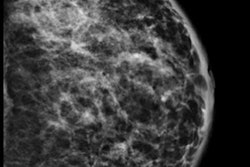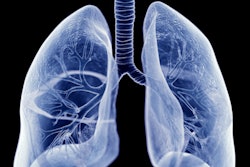
Mammography-guided, vacuum-assisted breast biopsy can help improve overall biopsy performance in women with compressed, thin breasts, according to research published on 5 May in the Asian Journal of Surgery.
A team led by Yun-Jen Yeow from Chang Gung Memorial Hospital in Taiwan found high identification of microcalcifications in these women, which it noted can be a technical challenge.
"[Mammography-guided vacuum-assisted breast biopsy] helps the management of suspicious microcalcifications discovered by mammography," Yeow and colleagues wrote.
When managing suspicious breast lesions found on mammography, mammography-guided vacuum-assisted needle breast biopsy is the standard method for diagnosis. However, in the case of women with compressed, thin breasts (3 cm thickness or less), biopsy performance may be limited due to not enough safety distance to the opposite side of the breast. This is also known as negative stroke margin.
While wire localization for surgery or interval mammographic follow-up may serve as alterative solutions for management, the researchers noted that these have been tied to oversurgery or delayed treatment of early cancers.
They also pointed out a lack of data on mammography-guided vacuum-assisted breast biopsy on compressed, thin breasts. Yeow and co-authors sought to test the method for the assessment of suspicious microcalcifications, and to compare results to control cases (compressed breast thickness greater than 3 cm).
The team used data collected between 2019 and 2021 from 745 consecutive women that included 195 compressed thin breasts. Of the total study cohort, 191 women underwent biopsy; 101 received stereotactic guidance and 90 received tomosynthesis guidance.
For compressed thin breasts, mammography-guided vacuum-assisted biopsy diagnosed 26 breast cancers, including five invasive carcinomas and 21 ductal carcinomas in situ (DCIS). This method also diagnosed 97 high-risk lesions and 68 benign pathologies, with the researchers reporting a cancer prevalence of 15.2%.
Forty-two women underwent subsequent surgeries, revealing 26 cancers, 15 atypia lesions, and one benign lesion. Of these 26 proven breast cancers, 23 were diagnosed by mammography-guided vacuum-assisted breast biopsy, translating to a sensitivity of 88.46%. The investigators also found that three cases of atypia were upgraded to cancers, for a 16.7% upgrade rate.
The group did not find significant differences in sensitivity, atypia, and DCIS upgrade rates with mammography-guided, vacuum-assisted breast biopsy in women with thin breasts compared with those with breast tissue thicker than 3 cm.
The study authors wrote that based on their results, mammography-guided vacuum-assisted breast biopsy is adequate for histologic diagnosis of thin breast tissue and may help women avoid unnecessary surgery for nonmalignant lesions.
"Using a large biopsy core needle, the diagnosis has been proven equivalent to surgery," they wrote. "In view of the cost and efficacy, [this method] has been established as a standard method effectively to diagnose suspicious microcalcifications for management."



















